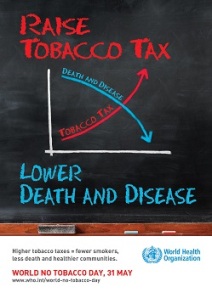 Every year, on 31 May, the World Health Organization (WHO) and partners everywhere mark World No Tobacco Day, highlighting the health risks associated with tobacco use and advocating for effective policies to reduce tobacco consumption. Tobacco use is the single most preventable cause of death globally and is currently responsible for 10 percent of adult deaths worldwide.
Every year, on 31 May, the World Health Organization (WHO) and partners everywhere mark World No Tobacco Day, highlighting the health risks associated with tobacco use and advocating for effective policies to reduce tobacco consumption. Tobacco use is the single most preventable cause of death globally and is currently responsible for 10 percent of adult deaths worldwide.
For World No Tobacco Day 2014, the WHO is calling on countries to raise taxes on tobacco.
Under the WHO Framework Convention on Tobacco Control (FCTC), countries should implement tax and price policies on tobacco products as a way to reduce tobacco consumption. Research shows that higher taxes are especially effective in reducing tobacco use among lower-income groups and in preventing young people from starting to smoke. A tax increase that increases tobacco prices by 10 percent decreases tobacco consumption by about four percent in high-income countries and by up to eight percent in most low- and middle-income countries.
Furthermore, increasing excise taxes on tobacco is considered to be the most cost-effective tobacco control measure. The World Health Report 2010 indicated that a 50 percent increase in tobacco excise taxes would generate a little more than US$ 1.4 billion in additional funds in 22 low-income countries. If allocated to health, government health spending in these countries could increase by up to 50 percent.
Learn more about World No Tobacco Day 2014.










